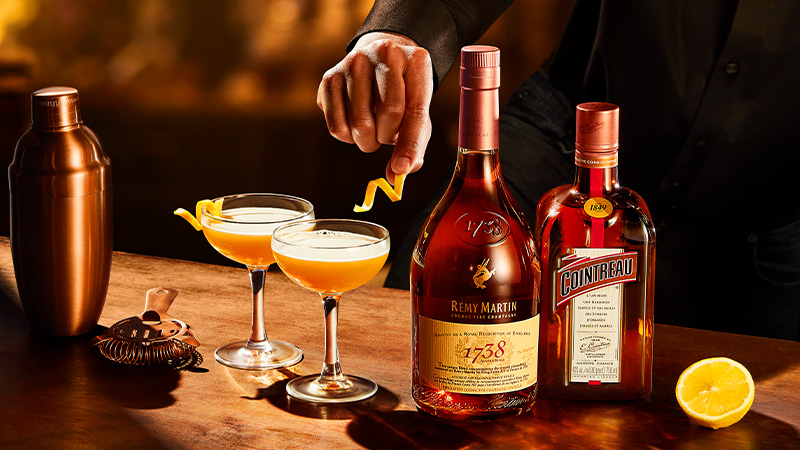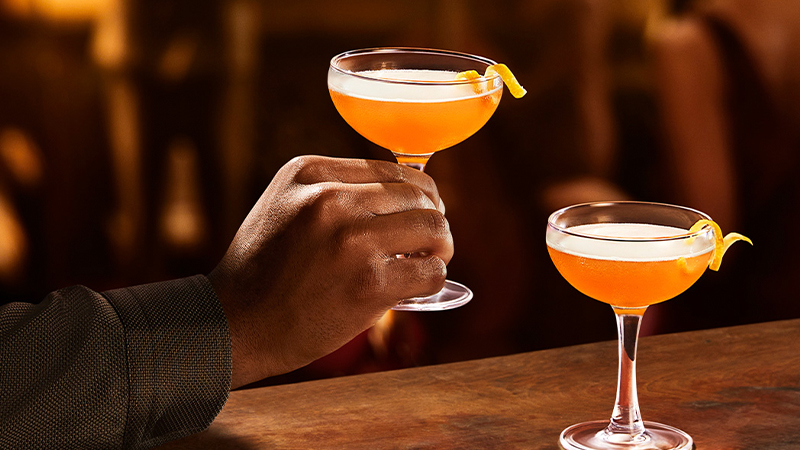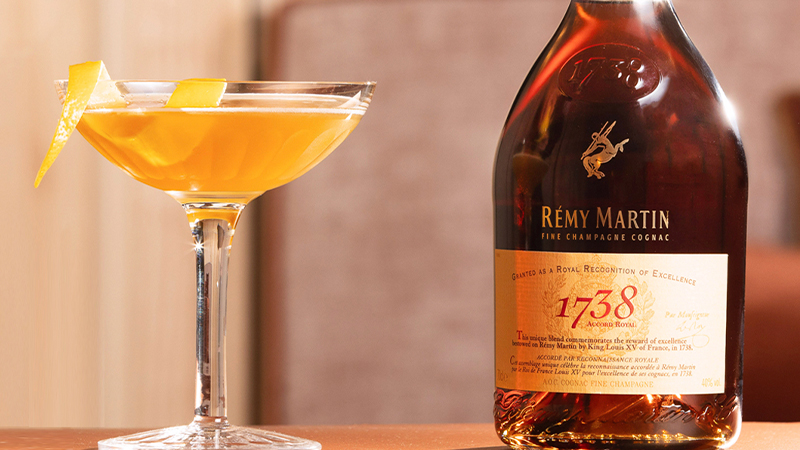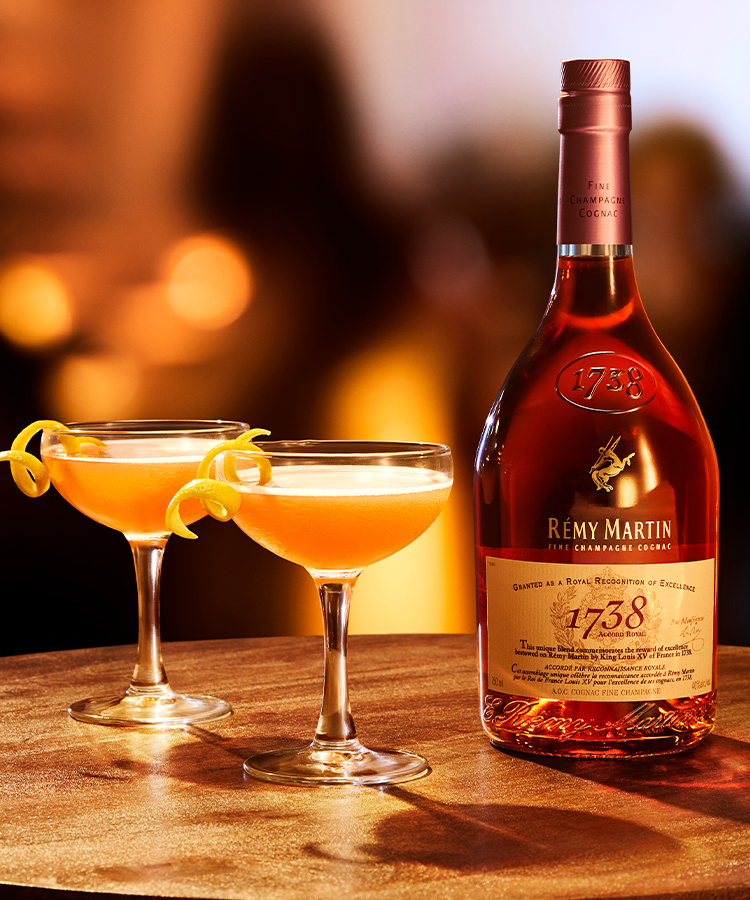
One could say that cocktails with the murkiest origin stories are the most fun to sip. Such is certainly the case with the Sidecar—a classic quaff of cognac, orange liqueur, and lemon juice that straddles the line between sour and sweet. Depending on whom you ask, the drink was either invented in Paris or London. Some swear by the addition of a sugared rim, while others cry heresy. Lively discussion swirls around whether one or two parts cognac is ideal. But cocktail historians agree that the first Sidecar was first poured in the years following World War I. In other words, people have been drinking Sidecars for a long, long time.
For any drink to stick around long enough to become a classic, it’s got to be delicious. In the wrong hands, a Sidecar can tilt too boozy or bland. But in the right hands—and with the right cognac, say a refined pour of Rémy Martin 1738 Accord Royal—it’s pure delight in cocktail form.

To fully appreciate the Sidecar’s tangy appeal, one must first dive into its hotly debated history. The drink likely evolved from a similar and equally fantastic cocktail called the Brandy Crusta, which legendary bartender Joseph Santini invented at his New Orleans drinking den, Jewel of the South, sometime in the mid-1800s. A blend of brandy, maraschino liqueur, curaçao, fresh lemon juice, and bitters, it boasts a generously sugared rim (hence why some prepare a Sidecar that way). The drink’s recipe likely crossed the Atlantic sometime after that—perhaps brought over by American expat bartenders fleeing Prohibition in the States—but where to is shrouded in mystery.
Did pioneering barman Harry McElhone of Harry’s New York Bar in Paris first riff on the brandy crusta to create the original Sidecar in 1922? McElhone claimed credit for it that year in his quintessential bartending tome, “Harry’s ABCs of Mixing Cocktails”. Others allege that it was instead Frank Meier of the Ritz Paris’s famous Hemingway Bar who shook up the first Sidecar the following year, in 1923. Complicating things further, however, is an earlier edition of McElhone’s book. Published in 1919, it credits the drink’s invention to Pat MacGarry, the bartender at Buck’s Club in London. All three men were said to have poured a mean version of the drink, but with one major difference: McElhone and MacGarry’s version is equal parts lemon, orange liqueur, and cognac, while Meier’s version is one part lemon, one part orange liqueur, and two parts cognac. These early versions lacked a sugared rim, but the sweet addition became a mainstay after it began showing up in Sidecar recipes from the 1930s.
As for the drink’s moniker? One explanation provides yet another twist in the cocktail’s birth story. In his 1948 book, “The Fine Art of Mixing Drinks”, David A. Embury writes that the Sidecar was “invented by a friend of mine at a bar in Paris during World War I and was named after the motorcycle sidecar in which the good captain customarily was driven to and from the little bistro where the drink was born and christened.” It’s generally accepted that the “little bistro” was, in fact, Harry’s New York Bar. Might Harry McElhone have invented the drink in honor of the captain? Could the sidecar-riding captain have possibly invented the cocktail himself, and slipped the recipe to McElhone? It’s a mystery lost to time, but either way, the tale lends the drink’s name a romantic backstory.

So, what ingredients make for the perfect Sidecar? Most important among them is arguably cognac, which can make or break the drink depending on which one is used. Orange liqueur and lemon juice impart powerful sweet and sour notes, so it’s imperative to choose a distinctive cognac that delivers a generous depth of flavor with which to cut through and balance them. Rémy Martin 1738 Accord Royal, named after a royal approval bestowed upon Rémy Martin by King Louis XV of France in 1738, is just the thing. Remarkably smooth and oaky, it delivers notes of toasted bread, vanilla, and brioche that shine brightly on its own or when featured in mixed drinks. For this reason, bartenders often favor the cognac’s classic, streamlined flavor profile when mixing old-school cocktails like the Sidecar.
But that’s not the only reason to choose a Rémy Martin Cognac as a Sidecar base. It’s extremely likely that the seminal bartenders of the 1920s and 1930s—people like Harry McElhone, Frank Meier, Pat MacGarry, and others—may very well have done the same. After all, it was 1927 when Rémy Martin first started making Rémy Martin Fine Champagne Cognac VSOP, its first expression made with Petite Champagne and Grande Champagne crus. The vintage became an overnight sensation for its superior quality, establishing it as go-to cognac for in-the-know bartenders.
Eager to whip up your own Sidecar? We can’t say we blame you. Try the below recipe for Rémy Martin’s Sidecar made with Rémy Martin 1738 Accord Royal—you won’t be disappointed.
RÉMY SIDECAR
Ingredients:
2 oz Rémy Martin 1738® Accord Royal
3/4 oz Cointreau®
3/4 oz lemon juice
Directions:
Pour 2 oz of Rémy Martin 1738 Accord Royal, 3/4 oz of Cointreau and 3/4 oz of lemon juice into a shaker filled with ice.
Strain and pour into a coupette glass.
Finish with orange peel for a rich flavor or lemon peel for freshness.

This article is sponsored by Rémy Martin®.
